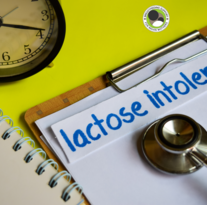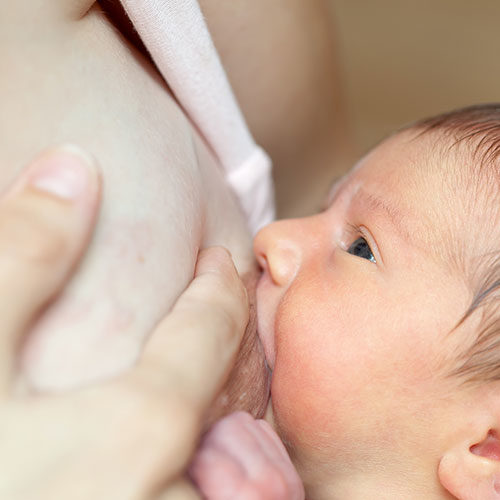What is Lactose Intolerance in babies?
Lactose Intolerance is the inability to digest lactose (milk sugar). This is not an allergy to milk. Lactose intolerance occurs when the body produces insufficient or no lactase. Lactase is an enzyme that is secreted in our small intestines to break down lactose.
Lactose intolerance is extremely rare in infants and young children below 2 years of age. To come to think of it, it makes complete sense. Breast milk is very rich in lactose and evolutionary speaking, it would be very important for babies to be able to produce enough lactase in order to thrive on the only food that nature made for them.
Types of Lactose Intolerance :
1) Primary Lactose Intolerance –
This is late-onset intolerance to lactose which is more common in adults. This happens due to the gradual reduction in the production of lactase in the person’s body. Therefore, it takes time to manifest. In most cases, the symptoms don’t show up until young adulthood. And the symptoms almost never show up before the age of 2-5 years. Thus, this is not the kind of lactose intolerance seen in babies.
2) Congenital Lactose Intolerance –
These are disorders present at birth and are inherited through heredity. Some examples include congenital lactose intolerance/deficiency, galactosemia etc. These disorders have symptoms like severe diarrhea, vomiting, dehydration and failure to thrive. These disorders require systematic medical treatment and guidance all throughout.
3) Secondary Lactose Intolerance –
The enzyme lactase is produced in the intestinal brush borders. When it gets damaged, the production of lactase suffers; resulting in temporary lactose intolerance. However, once the damage is healed, the production of lactase restores and the lactose intolerance disappears. It is important to find the right treatment early as prolonged damage may not heal, making lactose intolerance permanent. Damage to the gut lining can happen due to various reasons e.g. gastroenteritis (stomach flu), intolerance or allergy to certain food, celiac disease (gluten intolerance) and bowel surgery.
Lactose Intolerance in Babies and its Treatment :
The most common type of lactose intolerance amongst babies is the Secondary Lactose Intolerance. Treatment depends on whether or not a baby is breastfed or artificially fed.
A) Exclusively Breastfed Babies –
In EBF infants, the most common reasons for secondary lactose intolerance are gastroenteritis and intolerance or allergy towards food that are part of the mother’s diet, usually being dairy. If the reason is the stomach flu, appropriate medication is prescribed and breastfeeding is continued without interruption as it helps heal the gut lining. The average recovery time for babies below 3 months is around 4 weeks. If the reason for secondary lactose intolerance is the mother’s diet, elimination of the responsible ingredient resolves the issue. For babies older than 6 months, secondary lactose intolerance could be due to something they themselves ate, rather than what the mother ate. In all cases, breastfeeding must continue without interruption.
B) Artificially Fed Babies –
Lactose-free formula is recommended for the artificially fed babies having a secondary lactose intolerance. It is only recommended when a baby is malnourished and/or is losing weight. Donor milk can be sought in other cases. If the baby is combi-fed, breastfeeding must continue while replacing the formula with donor milk and trying to wean the baby off top milk. If the baby is given cow’s milk as a substitute to breast milk, the baby might have cow’s milk protein allergy and not lactose intolerance.
Some Frequently Suggested Treatments and their pros and cons:
Taking the baby off the breast or Alternating between Breastfeeding and Formula
Except for congenital lactose intolerance, this is never needed. In fact, if breastfeeding is stopped, the baby is deprived of optimal nutrition and the gut healing properties of breast milk are not received by the baby.
Lactose Free Formula
Lactose is essential for early rapid brain development of human infants. Therefore, removing lactose from a baby’s diet should only be done for a short term and under medical guidance. The lactose-free formula is recommended only in extreme cases where the baby is malnourished and/or losing weight.
Soya Formula
Soya formula can be helpful in cases of galactosemia. However, it is important to note that it is not recommended for babies below 6 months of age. Also, babies who are allergic to other milk proteins are usually also allergic to soy milk protein.
Lactase Drops
There is little evidence that it helps when administered as drops to the baby. And even when it does, it gives symptomatic relief but does not cure the issue. They may be easy to give to babies who are given expressed breast milk (EBM) or formula as it works when they are added to the expressed breast milk (or any other milk) and left for some hours for the enzyme to pre-digest the lactose in the milk for the baby.
Except for congenital lactose intolerance, lactose intolerance in babies always has a cause. The treatment should be aimed at finding that cause and resolving it.
Misdiagnoses
Due to the similarity of symptoms, some other issues are often misdiagnosed as lactose intolerance in babies. Below are some of the most common such issues.
A. Cow’s Milk Protein Sensitivity / Allergy (CMPA) –
This is often confused with lactose intolerance and some people think that they both are the same thing. This is not true. Cow’s milk protein and Lactose are both present in dairy products. So, it becomes difficult to determine which one is causing the symptoms. Additionally, if a baby has CMPA, it causes damage to her gut lining causing lactose intolerance. So, it becomes all the more difficult to determine the actual reason. CMPA can manifest in babies less than 6 months old if the mother’s diet includes dairy products, or if they are given cow’s milk as top-up. In order to diagnose lactose intolerance, CMPA should be ruled out first.
B. Lactose Overload in Babies –
Sometimes babies may show the symptoms of lactose intolerance not due to lactase deficiency, but due to lactose overload which overwhelms the baby’s digestive system. This happens due to the foremilk-hindmilk imbalance.
Foremilk (the milk that starts flowing first as the baby begins nursing) is high in lactose and low in fat. The hindmilk (the milk that comes later in the nursing session) is high in fat and low in lactose. When there is more consumption of the foremilk, the baby receives too much lactose. This is called lactose overload.
- It is more common in babies whose mothers have oversupply. When milk production is too high, the baby fills up on the foremilk itself.
- When the mother switches the sides too often while nursing, or before the baby drains the breast, the baby ends up getting foremilk from both sides.
Striking the foremilk-hindmilk balance resolves this issue.
References:
https://kellymom.com/health/baby-health/lactose-intolerance/
https://www.breastfeedingnetwork.org.uk/lactose-intolerance-and-breastfeeding/
https://www.breastfeeding.asn.au/bf-info/lactose
https://www.laleche.org.uk/unhappy-baby/#lactose

Wish to speak with a member of our team who is a certified lactation professional and also an experienced breastfeeding mother, click on this link.
Medical Advice Disclaimer
THIS WEBSITE DOES NOT PROVIDE MEDICAL ADVICE.
The information, including but not limited to, text, graphics, images and other material contained on this website are for informational purposes only. No material on this site is intended to be a substitute for professional medical advice, diagnosis or treatment. Always seek the advice of your physician or other qualified health care provider with any questions you may have regarding a medical condition or treatment before undertaking a new health care regimen, and never disregard professional medical advice or delay in seeking it because of something you have read on this website.
Disclaimer
We understand and acknowledge that parents and babies can be of various genders on a spectrum of LGBTQI+. Families come in diverse flavours. However, in our articles, for the sake of simplicity and convenience, we will be referring to the breastfeeding parent as the mother and using the female pronouns- ‘she’ and ‘her’ for babies. Babies can be nourished and nurtured in different ways and while we have used the terms breastfeeding and nursing, we recognize that parents can opt to chest feed or finger feed.
We don’t have conflicts of interest and declare, and we are compliant with the WHO code of marketing of breastmilk substitutes and the IMS act.
In case you find any information on this website that needs to be updated, please write to us at info@bsim.org.in






